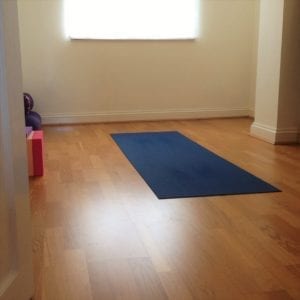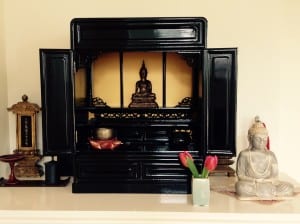Find a quiet retreat for the practice of yoga, sheltered from the wind, level and clean, free from rubbish, smouldering fires, and ugliness, and where the sound of waters and the beauty of the place help thought and contemplation.
Svetasvatara Upanishad
As a teenager many years ago, I visited my late maternal grandmother’s home on Shikoku, the smallest of Japan’s four main islands.
Having lived in England for the previous 10 years, what struck me most was the warm emptiness and calm of her home. I suppose it was what would now be loosely described as ‘zen’. Minimalist, with traditional tatami mat flooring, rice-paper sliding doors rather than walls between rooms, mattresses that were rolled up and put away each day and very little furniture. I have carried this memory and feeling with me throughout my life, and replicated it in places I have lived in.
The look and feel of the space you choose for your yoga home practice is entirely personal. It’s a bit like the space we work in: some of us are happy working at a very messy desk with piles of paper everywhere, while others can’t bear this and need a clear space.
A serene emptiness is the type of space I enjoy being in for my home practice. You can see my practice room below. It is bare, but not barren (I have a couple of pictures on the walls and an altar, seen below). I have practised in this room for the past eight years and a familiar, welcoming energy is firmly implanted there.

Here I offer some thoughts and tips on how to create a space that is perfect for practising at home. Please take or leave whichever points feel right for you.
Cosy
Take whatever you need to bring cosiness to your space. Whatever the size of the space, choose the colour(s) and texture(s) around you. This immedately brings a sense of comfort, ease and security, all of which can only support us in our practice. This is particularly true if we wish to approach more challenging aspects of the practice and delve into increasing levels of svadhyaya or self-study. The latter extends our comfort zone.
Warmth is essential, not only a physiological level to ensure comfort and wellbeing, but also for ease of movement and safety, as soft tissue injuries, for example, are more likely to arise when the body is cold. In the colder months I always welcome a little extra heat in my practice space.
Clean
Cleanliness, or sauca is the first of the niyamas or personal observances mentioned in the Yoga Sutras attributed to Patanjali.
Such a simple, essential factor has an effect on the energy of the space and its influence on our frame of mind. A clean space is like breathing in clean air and clearing the mind. Cleanliness is also part of showing respect for the practice, and ourselves.
The Hatha Yoga Pradipika says that the place of sadhana, spiritual practice, ‘should be spotlessly clean‘.
Uncomplicated
As the mind can be busy enough as it is (an understatement probably), minimising distractions is important.
The Yoga Sutras name distractions as a cause of restlessness in the mind which is one of the obstacles to practice and reaching samadhi (bliss, realisation).
The less external stimulation around us, the better chance we have of internalising the senses and thereby accessing insight. The ancient yoga texts give us the beautiful analogy of a tortoise gently drawing in its limbs and head into quietness.
A few choice, meaningful items in the space are all that is needed.
Special
Yoga is a spiritual practice, whether we choose it to be or not. This realisation inevitably comes to us over time, as we become less and less influenced and disturbed by the external world and more acutely attuned to the internal world and something higher.
Some like to practice with an altar in the space. Mine has been passed on to me through my family, having been with us since the sixties (and packed away for some thirty years). It is meaningful to me, while not being distracting. I light two candles and at the end of practice close the doors that you can see on either side of the shrine:

Many devoted practitioners have pictures of deities or teachers from their lineage.
If this doesn’t feel right for you, just a candle or some fresh flowers also elevate the energy of the space.
We are generally advised not to include photographs of family members in the practice space in order to be free of emotional distraction.
Equipped
It is worth investing in props and whatever you need to support you in your practice. Ensure you have everything easily to hand, so that you can move freely from one part of your practice to the next, without the interruption of having to source something in between.
The most essential props are, I would suggest: a mat, two blocks, two bricks, a belt, two bolsters (or rolled up blankets), two blankets and an eye pillow. If I am on the road I sometimes even practice without any of these, so flexibility is valuable, as is improvising with whatever you may find around you – towels, cushions, books, furniture or trees and rocks if you are practising outdoors!
It is reassuring to know that with time, practice in itself becomes so absorbing and such a sanctuary that we are able to contentedly practice anywhere: we feel at home everywhere and our surroundings no longer influence our experience. Until then, it is worth taking care to create a supportive environment and to have one at home, readily available to nurture us on our way.
You may also like:
The secrets of sustainlable self-practice